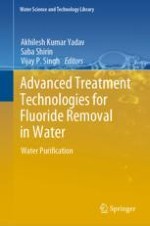2023 | OriginalPaper | Buchkapitel
18. Environmental and Health Effects of Fluoride Contamination and Treatment of Wastewater Using Various Technologies
verfasst von : Ankit Kumar, Ramakrishna Chava, Sonam Gupta, Saba Shirin, Aarif Jamal, Akhilesh Kumar Yadav
Erschienen in: Advanced Treatment Technologies for Fluoride Removal in Water
Verlag: Springer Nature Switzerland
Aktivieren Sie unsere intelligente Suche, um passende Fachinhalte oder Patente zu finden.
Wählen Sie Textabschnitte aus um mit Künstlicher Intelligenz passenden Patente zu finden. powered by
Markieren Sie Textabschnitte, um KI-gestützt weitere passende Inhalte zu finden. powered by
